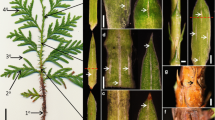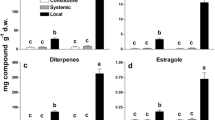Abstract
Studies were conducted to determine whether herbivore-induced synthesis of monoterpenes occurs in the needles of ponderosa pine (Pinus ponderosa Lawson), lodgepole pine (P. contorta Douglas var. latifolia Engelmann), white fir (Abies concolor Lindl. and Gordon) and Engelmann spruce [Picea engelmanii (Parry) Engelm.]. In the needles of all species except Engelmann spruce, simulated herbivory significantly induced the activity of monoterpene cyclases 4–8 days after wounding. In ponderosa pine, real herbivory by last-instar tiger moth larvae (Halisdota ingens Hy. Edwards: Lepidoptera) induced a significantly larger response (4.5-fold increase in monoterpene cyclase activity) than did simulated herbivory (2.5-fold increase). To our knowledge, this is the first report of herbivore-induced increases in monoterpene synthesis in needle tissue. Despite this increase in monoterpene synthesis, we observed no significant increase in total monoterpene pool size in wounded needles compared to controls. Large increases in the rate of monoterpene volatilization were observed in response to wounding. We conclude that the volatile losses caused by tissue damage compensate for herbivore-induced monoterpene synthesis, resulting in no change in pool size. Tiger moth larvae consume ponderosa pine needles in a pattern that begins at the tip and proceeds downward to midway along the needle, at which point they move to an undamaged needle. Constitutive monoterpene concentrations and monoterpene cyclase activities were highest in the lower half of ponderosa pine needles. The monoterpene profile also differed between the upper and lower needle halves, the lower half possessing an additional one to four monoterpene forms. We propose that the increasing gradient in monoterpene concentrations and number of monoterpenes along the needle from tip to base deters feeding beyond the midway point and provides time for the induction of increased cyclase activity and production of new monoterpenes. The induction of new monoterpene synthesis may have a role in replacing monoterpenes lost through damage-induced volatilization and preventing extreme compromise of the constitutive defense system.
Similar content being viewed by others
Author information
Authors and Affiliations
Additional information
Received: 4 June 1997 / Accepted: 2 December 1997
Rights and permissions
About this article
Cite this article
Litvak, M., Monson, R. Patterns of induced and constitutive monoterpene production in conifer needles in relation to insect herbivory. Oecologia 114, 531–540 (1998). https://doi.org/10.1007/s004420050477
Issue Date:
DOI: https://doi.org/10.1007/s004420050477




